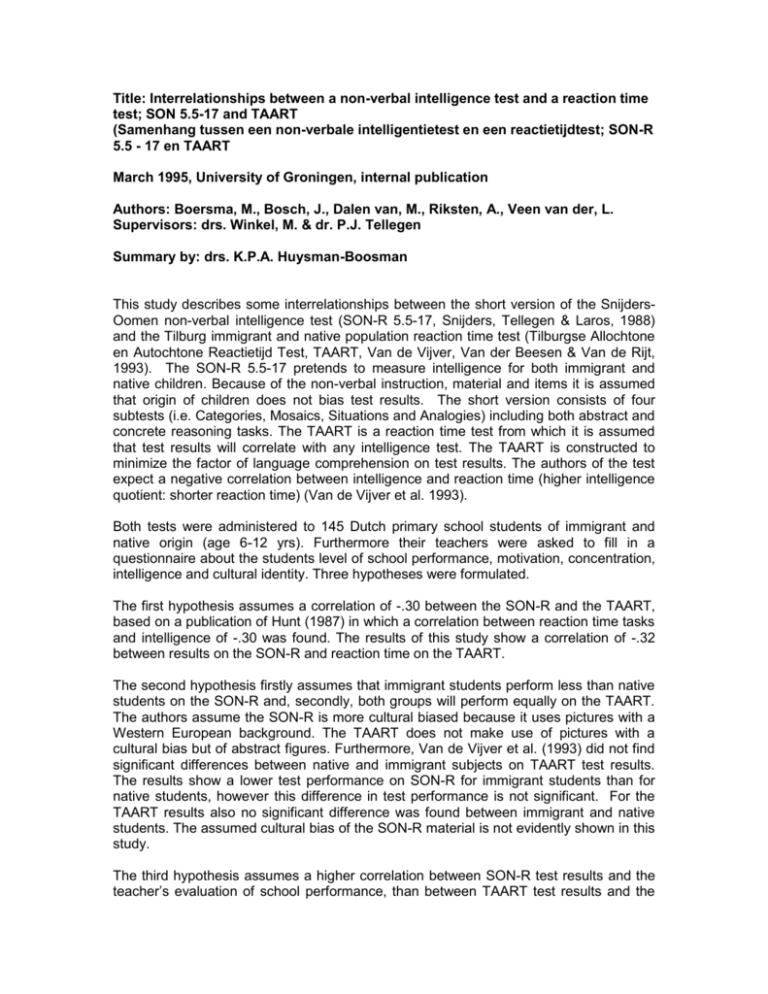Summary - Tests & Test
advertisement

Title: Interrelationships between a non-verbal intelligence test and a reaction time test; SON 5.5-17 and TAART (Samenhang tussen een non-verbale intelligentietest en een reactietijdtest; SON-R 5.5 - 17 en TAART March 1995, University of Groningen, internal publication Authors: Boersma, M., Bosch, J., Dalen van, M., Riksten, A., Veen van der, L. Supervisors: drs. Winkel, M. & dr. P.J. Tellegen Summary by: drs. K.P.A. Huysman-Boosman This study describes some interrelationships between the short version of the SnijdersOomen non-verbal intelligence test (SON-R 5.5-17, Snijders, Tellegen & Laros, 1988) and the Tilburg immigrant and native population reaction time test (Tilburgse Allochtone en Autochtone Reactietijd Test, TAART, Van de Vijver, Van der Beesen & Van de Rijt, 1993). The SON-R 5.5-17 pretends to measure intelligence for both immigrant and native children. Because of the non-verbal instruction, material and items it is assumed that origin of children does not bias test results. The short version consists of four subtests (i.e. Categories, Mosaics, Situations and Analogies) including both abstract and concrete reasoning tasks. The TAART is a reaction time test from which it is assumed that test results will correlate with any intelligence test. The TAART is constructed to minimize the factor of language comprehension on test results. The authors of the test expect a negative correlation between intelligence and reaction time (higher intelligence quotient: shorter reaction time) (Van de Vijver et al. 1993). Both tests were administered to 145 Dutch primary school students of immigrant and native origin (age 6-12 yrs). Furthermore their teachers were asked to fill in a questionnaire about the students level of school performance, motivation, concentration, intelligence and cultural identity. Three hypotheses were formulated. The first hypothesis assumes a correlation of -.30 between the SON-R and the TAART, based on a publication of Hunt (1987) in which a correlation between reaction time tasks and intelligence of -.30 was found. The results of this study show a correlation of -.32 between results on the SON-R and reaction time on the TAART. The second hypothesis firstly assumes that immigrant students perform less than native students on the SON-R and, secondly, both groups will perform equally on the TAART. The authors assume the SON-R is more cultural biased because it uses pictures with a Western European background. The TAART does not make use of pictures with a cultural bias but of abstract figures. Furthermore, Van de Vijver et al. (1993) did not find significant differences between native and immigrant subjects on TAART test results. The results show a lower test performance on SON-R for immigrant students than for native students, however this difference in test performance is not significant. For the TAART results also no significant difference was found between immigrant and native students. The assumed cultural bias of the SON-R material is not evidently shown in this study. The third hypothesis assumes a higher correlation between SON-R test results and the teacher’s evaluation of school performance, than between TAART test results and the teacher’s evaluation. This assumption is based on a study of Van de Vijver et al. (1994) in which a correlation of .30 is found between TAART results and school performance and a study of Snijders et al. (1988) in which correlations of .40 and .49 (age 7-9 and 1011 resp.) were found between SON-R results and school performance. The results of this study show higher correlations between SON-R performance and teacher’s evaluation than between TAART performance and teacher’s evaluation. Only one correlation between TAART performance and the teacher’s evaluation (comprehensive reading) was significant, nine out of eleven correlations between SON-R performance and teacher’s evaluation of school performance showed to be significant (see Table 1). Table 1 Correlations between test performance and teacher’s evaluation of school performance (n=65) School performance Intelligence Motivation Concentration Technical reading Comprehensive reading Spelling Mental arithmetic Arithmetic Redaction sums Writing SON-IQ .58* .62* .31* .22 .39* .54* .48* .47* .49* .58* .24 TAART .31 .33 .15 .05 .35 .38* .31 .22 .27 .33 .24 * significant with alpha .01 References Hunt, E.B. (1987). The next word on verbal ability (1). In: P.A. Vernon (red.), Speed of information-processing and inlelligence, 347-392. Norwood: NJ: Ablex. Snijders, J. Th., Tellegen, P.J., Laros, J.A. (1988). SON-R 5.5-17. Verantwoording en handleiding. Groningen: Wolters-Noordhoff. Vijver, F.J.R. van de, Beesen, J. van der, Helms-Lorenz, M. (1994). TAART, de Tilburgse Allochtonen en Autochtonen Reactietijd Test, handleiding. Tilburg: Katholieke Universiteit Brabant. Vijver, F.J.R. van de, Willemse, G.R.W.M., Rijt, B.A.M. van de (1993). Het testen van cognitieve vaardigheden van allochtone leerlingen. De Psycholoog, 4, 152-159.